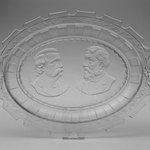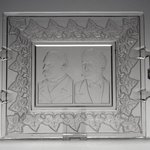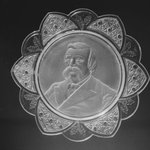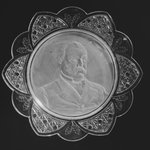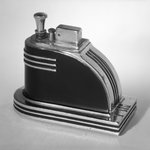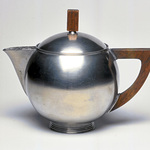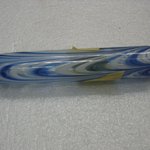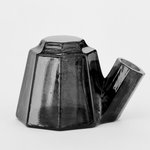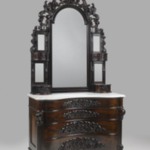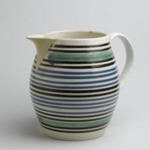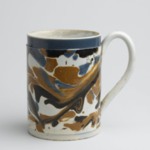
Decanter
Decorative Arts and Design
The ceramics and glassware here show how the dictates of the machine and cost-consciousness helped establish an incipient taste for abstract decoration in early nineteenth-century design. When the Industrial Revolution began, high-quality ceramics and glassware were only available to the rich and porcelain was embellished by hand with naturalistic or narrative decoration. Industrial manufacturers began to adopt production-line techniques, using molds to produce large quantities of affordable earthenware ceramics and glass intended for the growing middle classes. To keep prices down, makers devised new means of decoration that produced simple, geometric designs or abstract patterns. The pitcher and large mug here were turned mechanically on a lathe while a quill infused with colored slip, or clay, created remarkably simple, striped designs. The random decoration on the smaller mug (meant to imitate the natural veining of marble) and the glass vessels embrace the element of chance, an entirely modern notion of artistic creation that reached its greatest flowering with Abstract Expressionist painting in the mid-twentieth century.
MEDIUM
Glass
DATES
ca. 1750–1810
DIMENSIONS
9 3/4 x 6 1/2 in. (24.8 x 16.5 cm) (show scale)
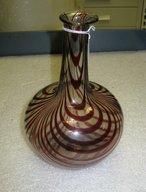


COLLECTIONS
Decorative Arts and Design
ACCESSION NUMBER
13.927
CREDIT LINE
Purchased by Special Subscription and Museum Collection Fund
EXHIBITIONS
MUSEUM LOCATION
This item is not on view
CAPTION
Decanter, ca. 1750–1810. Glass, 9 3/4 x 6 1/2 in. (24.8 x 16.5 cm). Brooklyn Museum, Purchased by Special Subscription and Museum Collection Fund, 13.927. Creative Commons-BY (Photo: Brooklyn Museum, CUR.13.927.jpg)
IMAGE
overall, CUR.13.927.jpg. Brooklyn Museum photograph, 2011
"CUR" at the beginning of an image file name means that the image was created by a curatorial staff member. These study images may be digital point-and-shoot photographs, when we don\'t yet have high-quality studio photography, or they may be scans of older negatives, slides, or photographic prints, providing historical documentation of the object.
RIGHTS STATEMENT
Creative Commons-BY
You may download and use Brooklyn Museum images of this three-dimensional work in accordance with a Creative Commons license. Fair use, as understood under the United States Copyright Act, may also apply.
Please include caption information from this page and credit the Brooklyn Museum. If you need a high resolution file, please fill out our online application form (charges apply).
For further information about copyright, we recommend resources at the United States Library of Congress, Cornell University, Copyright and Cultural Institutions: Guidelines for U.S. Libraries, Archives, and Museums, and Copyright Watch.
For more information about the Museum's rights project, including how rights types are assigned, please see our blog posts on copyright.
If you have any information regarding this work and rights to it, please contact copyright@brooklynmuseum.org.
RECORD COMPLETENESS
Not every record you will find here is complete. More information is available for some works than for others, and some entries have been updated more recently. Records are frequently reviewed and revised, and we welcome any additional information you might have.




